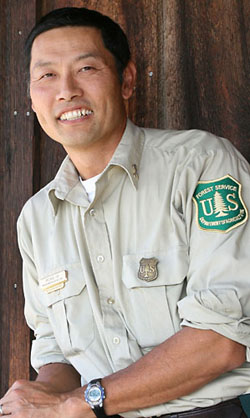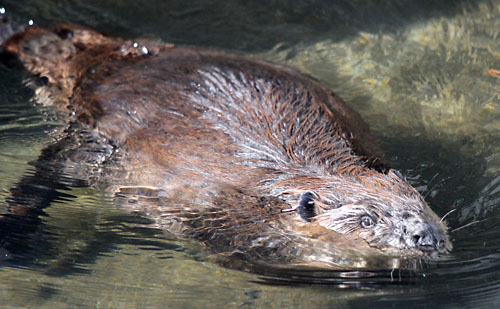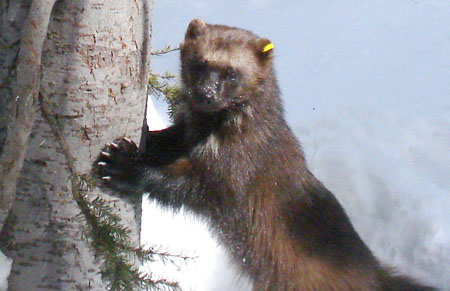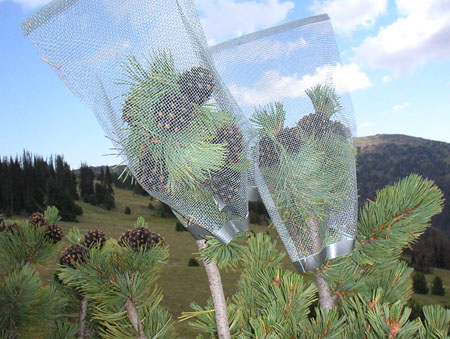home | internet service | web design | business directory | bulletin board | advertise | events calendar | contact | weather | cams

 Methow Valley District Ranger Mike Liu. Photo by Solveig Torvik Methow Valley District Ranger Mike Liu. Photo by Solveig TorvikMajestic Money The upper Methow Valley is among 14 U.S. Forest Service locations chosen by the National Forest Foundation for a five-year, $2 million ecological restoration effort as part of the foundation’s Treasured Landscapes conservation campaign. The Methow Valley Ranger District restoration work will focus on re-establishing beaver and the whitebark pine, and monitoring wolverines. Another goal is installing culverts that prevent erosion of sediments into streams - for instance, near Dead Horse Point on the Harts Pass road, according to District Ranger Mike Liu. The foundation’s implementation plans for the ranger district includes restoring heavily used recreation areas such as Blue Lake and Cutthroat Pass, expanding the bridge abutment on Goat Creek to allow higher flow capacity, relocating campsites away from eroding river banks, keeping hikers on designated trails, promoting ecologically sustainable recreation and installing large woody debris or boulders to enhance in-stream habitat complexity. So are restoring historic sheep and cattle grazing areas in the Pasayten Wilderness and closing and revegetating some user-created trails. Road erosion, introduction of invasive species by recreationists and degraded fish and wildlife habitat are among other issues to be addressed by the conservation restoration campaign. All of these goals arise from the Forest Service’s own initiatives but Congress has not provided full funding, according to Liu. “We don’t come in and say [to the agency]: `Here’s what we think you should do on the ground,’” said the foundation’s regional director in Seattle, Kathleen Dowd-Gailey, who stressed that the foundation does not make policy for the Forest Service. Rather, she and Liu said, the foundation looks for established but federally unfunded Forest Service initiatives that match the foundation’s mission to “engage Americans in community-based and national programs that promote the health and public enjoyment” of the national forests.  Methow Valley beavers are set to receive help through Majestic Methow funding. Photo by Solveig Torvik Methow Valley beavers are set to receive help through Majestic Methow funding. Photo by Solveig TorvikHalf the cost of the Majestic Methow campaign on the Okanogan-Wenatchee National Forest will be borne by the Forest Service, which will provide such in-house services as analysis and design expertise. The other half will be paid for by private donors to the forest foundation, which was created by an act of Congress in 1991 to raise money for the agency. The Missoula-based foundation is modeled on other congressionally-chartered private fund-raising foundations such as one previously established for the U.S. National Park Service. Of the foundation’s $16.5 million budget for 2013, $3.5 million comes from Congress to be dispersed for forest conservation projects, said foundation president, Bill Possiel; the rest is donated by individuals, corporations and foundations. The foundation has 18 paid staff and spends 15 percent of its budget on salaries and overhead, he said. “We don’t lobby. We don’t take positions,” Possiel told Grist. Until 2001, the foundation was run by Forest Service employees untrained in non-profit work and operated out of its facilities, he said. “It was not very effective or successful,” Possiel said, partly because that approach focused on the needs of the Forest Service rather than those of the forests. Now, he said, the foundation “holds the forest service at arms length. We are not a quasi-government organization. We work closely with the Forest Service but we don’t report to the Forest Service.” Since its change of focus in 2001, the foundation has facilitated the planting of more than 3 million trees and shrubs, repair of 8,000 miles of trail, the reduction of fire risk on 79,000 acres, and treatment of 61,000 acres for noxious weeds. It has enlisted 71,000 volunteers who’ve contributed more than 1 million hours, according to its website.  A wolverine named ‘MelanieII’ was photographed on the Methow Valley Ranger District. Photo courtesy of the Methow Valley Ranger District A wolverine named ‘MelanieII’ was photographed on the Methow Valley Ranger District. Photo courtesy of the Methow Valley Ranger DistrictThe foundation stresses community involvement and the role of personal responsibility by citizens in a civil society for preservation of their public lands, according to Possiel. “The current [Forest Service] leadership totally understands and is behind what the National Forest Foundation stands for,” he added, and the head of the agency is a non-voting member of the foundation’s board. "As we become urbanized there are more people who are disconnected [from public lands] and don’t really understand the benefits they receive from public lands,” said Possiel, who added that a goal of his organization is to raise awareness of those benefits among Americans wherever they live. Though the foundation administers private gifts for forest projects, said Dowd-Gailey, it does not do any of the hands-on work itself. That’s left to the organizations that apply to receive funding for projects and meet the foundation and agency’s criteria for participating in public-private partnerships on national forest lands. “We’re not a membership organization,” Dowd-Gailey told Grist. The foundation has a roster of 3,000 private donors, plus nearly 80,000 subscribers to its newsletter, she said. Concern over the damaging effects of global warming helped drive the selection of the Methow’s forests for attention, according to the implementation plan, which puts it this way: “The Methow is undergoing significant ecological shifts and experiencing new kinds of pressures; from an explosion of forest insect infestations and disease epidemics to dense, fire-excluded forest stands that result in uncharacteristically severe wildfires. The valley landscape looks very different from the open fire- maintained conditions of the past. From forest ecosystems to riparian habitats, conditions have changed dramatically over the last century. The landscape today is part of the forest crisis brought on by the impacts of past timber harvest, livestock grazing, road construction and fire suppression. It is likely that climate change will exacerbate these threats in the near future. Scientists generally agree active, landscape-scale restoration is needed if the forest is to become resilient to these threats.”  Cages over whitebark pine cones make sure that the seeds stay intact for collection. Photo courtesy of the Methow Valley Ranger District Cages over whitebark pine cones make sure that the seeds stay intact for collection. Photo courtesy of the Methow Valley Ranger DistrictThe plight of the slow-growing whitebark pine is cited in the plan as an example of the challenges facing the forest. The tree grows on windswept granite ridge tops at elevations of 5,500 feet or more and rarely reaches taller than 80 feet. For seed dispersal, it relies on Clark’s nutcracker, which opens the trees’ cones with its beak and hides the seeds to eat later. Because it historically has been too cold for mountain pine beetles in the whitebark’s neighborhood, the tree has not been much plagued by the beetles. But warmer temperatures have brought the beetles up to the whitebark pine, with what the document describes as “dramatic” effects of tree-killing infestations. The difficulties of preserving the whitebark pine recently were highlighted when a pilot for North Cascades Heli-Skiing of Mazama cut 42 of the trees to make a safer landing place for helicopters. The company’s operating permit did not allow removal of the trees without authorization - the agency shortly will bill owner Paul Butler $5,800 for restitution, according to Jennifer Zbyszewski, recreation manager for the district. Determining the value of the loss of the typically crooked trees “was a tough thing to do because they don’t have value as timber,” she explained. But after checking with two nurseries, the ranger district put each tree’s value at $92.50. No criminal penalties were sought, she said, because agency officials were persuaded that the act was not a “willful” breach of the permit, though she added that the company has been put on a “probationary status.” The money will be used to pay for 100 seedlings and the agency’s labor costs to plant them. “We’re hoping for a 50 percent survival rate,” she said. Liu said the agency has been collecting whitebark seeds “in an effort to retain some of the genetic material” of a tree that Liu said may be headed for inclusion on the federal list of threatened or endangered species. The ranger district plans to plant hundreds of seedlings on four acres in an old burn site in the Pasayten Wilderness, he added. The foundation’s Majestic Methow campaign will be coordinated by a group of local volunteers chosen by Dowd-Gailey, she told Grist, adding: “We’re very excited to work with the local community.” She and Liu will give a presentation on the campaign’s goals at the North Cascades Basecamp’s Jan. 17th Soup and Presentation evening in Mazama. Cost for soup and bread is $10, and soup’s on at 5:30 p.m. The presentation starts at 6 p.m. 1/8/2013 Comments
|